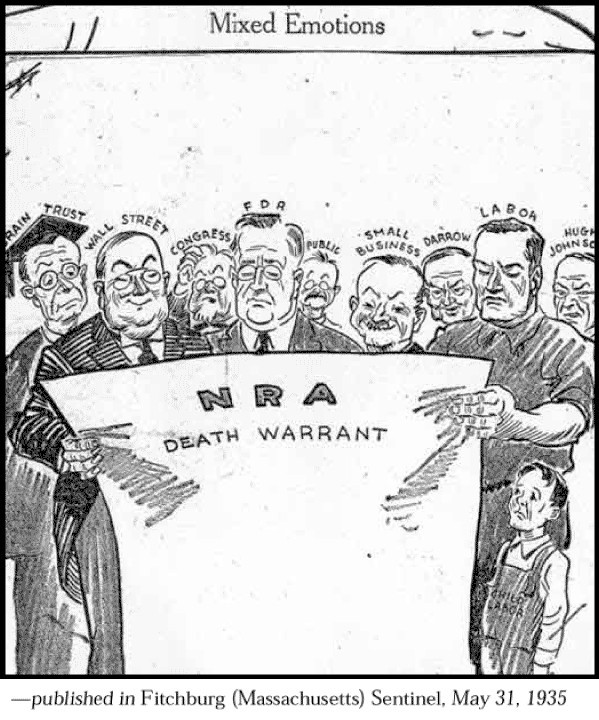Chapter 23 Review
Choose the
letter of the best answer.
____ 1. What
was the first major action Roosevelt took as president?
A.
He
called
the
first
meeting
of
the
"Brain
Trust."
B.
He
proposed
a
reorganization of the Supreme Court.
C.
He
closed
all
of
the
nation's
banks and
ordered
inspections.
D.
He
established
the
Civil
Works Administration to
provide
job
relief.
____ 2. Who
was the first woman to serve in the cabinet?
A.
Arlene
Francis
B.
Frances Perkins
C.
Eleanor
Roosevelt
D.
Mary
McLeod
Bethune
____ 3. Which
of the following was a goal
of the New Deal?
A.
regulate
the
stock
market
B.
deregulate
the
nation's
banking
system
C.
decrease
prices of
farm
goods
D.
increase
crop
production
____ 4. Which of the following was
most directly responsible
for creating
new jobs and putting
people to work?
A.
Social
Security
Act
B.
Fair
Labor Standards
Act
C.
National
Labor
Relations
Act
D.
Works
Progress Administration
____ 5. Which of the following was
the main objective of
the Agricultural Adjustment Act?
A.
to
increase
farm
production
B.
to raise prices of farm products
C.
to provide pensions for retired farmers
D.
to
encourage
more
people to
enter
farming
____ 6. Which of the following
pieces of New Deal legislation
was ruled unconstitutional by the Supreme Court?
A.
Wagner
Act
B.
Social
Security
Act
C.
Emergency
Banking Relief
Act
D.
National
Industrial Recovery
Act
____ 7. What
role did Eleanor
Roosevelt play in the Roosevelt
administration?
A.
She
served
as
a
cabinet
member.
B.
She
focused
on
being
an
excellent
hostess.
C.
She
was an
important
advisor on
foreign
policy.
D.
She
was an
important
advisor on
domestic
policy.
____ 8. Which
of the following reached a new high during
Roosevelt's first term as president?
A.
tariff
rates
B.
employment
rates
C.
the
national
debt
D.
per
capita
income
____ 9. Which of the following of
Roosevelt's ideas failed to become a law?
A.
federally
supported loans for
housing
B.
the
reorganization
of
the
Supreme
Court
C.
the
establishment
of
regional
planning
authorities
D.
the
creation
of
a
federally supported pension program
____ 10. Who wrote the novel The Grapes of Wrath about
the grim lives of Oklahomans fleeing the Dust Bowl during the Depression?
A.
Grant
Wood
B.
John
Steinbeck
C.
Richard
Wright
D.
Dorothea
Lange
Using the
exhibit, choose the letter
of the best answer.

____ 11. Which
of the following rivers appears to have
the most dams built on it?
A.
Ohio
River
B.
Tennessee
River
C.
Cumberland
River
D.
Clinch
River
____ 12. Which
is the northernmost dam illustrated
on this map?
A.
Guntersville
B.
Fort
Patrick
Henry
C.
Kentucky
D.
Norris
____ 13. According
to the map, which river in Tennessee
does not have any dams
built on it?
A.
Ohio
River
B.
Cumberland
River
C.
Clinch
River
D.
Duck
River
____ 14. If you were traveling
east along the Tennessee River, which dam would you encounter next
after passing the Wheeler Dam?
A.
Wilson
B.
Guntersville
C.
Nickajack
D.
Pickwick
Landing
____ 15. Approximately how many miles is it, measuring in
a straight line, from the Kentucky Dam to the Pickwick
Landing Dam?
A.
50
miles
B.
100
miles
C.
150
miles
D.
200
miles

____ 16. In
the
cartoon, the "NRA
Death Warrant" represents ___.
A.
the
NRA's limiting
the
production
of
goods
B.
Roosevelt's
attempts to
silence
New
Deal
critics
C.
the
NRA's putting
an
end
to
child
labor
D.
the
Supreme
Court's declaring the
NIRA
unconstitutional
____ 17. In the cartoon,
the character that represents Child Labor feels ___ about
the NRA death warrant.
A.
happy
B.
unhappy
C.
angry
D.
confused
Key
1.
C
2.
B
3. A 4. D
5. B
6. D 7. D 8. C
9. B 10.
B 11. B 12. C
13. D 14. B
15. C 16. D
17. B
Last Updated
6/2/2015

